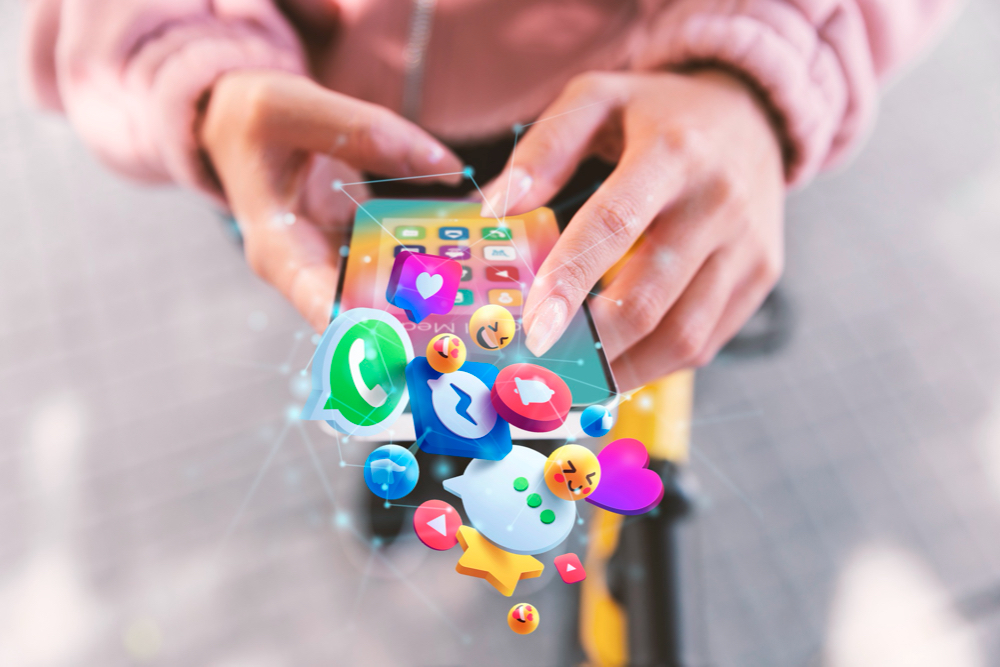- Fast results
- 4,000+ locations
- 4.8 star rating
Need Help? (888) GET LABS


If you’re unconsciously spending hours on devices and online apps, you may be at risk of developing technology addiction. This behavioral problem stems from excessive and uncontrollable use of a certain technology, which can go further down to a specific mental disorder like depression and social anxiety. Learn what this addiction is all about, the types to recognize, and other key information below.
Technology addiction, also known as digital addiction or internet addiction disorder (IAD), entails compulsive and overreliance on technology platforms, such as smartphones, social media, online pornography, etc.
While not clinically recognized as an official mental disorder, internet addiction follows a pathway similar to other types of addictions. Hence, there is a push from several experts to include in the upcoming version of the Diagnostic and Statistical Manual of Mental Disorders (DSM-5)(1).
People addicted to technology experience tiny surges of dopamine, which is the neurotransmitter that triggers pleasure. It is a crucial component of the brain’s reward system.
As technology usage becomes too frequent, you become desensitized to normal dopamine levels, leaving you craving for more. This results in spending more and more time using the device, making it difficult to detach. In such cases, individuals with internet addiction experience dopamine withdrawal symptoms similar to other forms of addiction, like smoking and alcoholism.
Not everyone who uses technology excessively develops addictive behaviors. Most who do have underlying mental health problems that make them more vulnerable to the condition.
Addiction to technology is complex, not just because it’s influenced by other factors outside device usage, such as hormonal imbalance. It is also further narrowed down to categories based on the type of technology or online platform you spend most of your time with or are having problems withdrawing from. The following are the most common types of technology addiction.

Addiction to social media is characterized by excessive and irresistible use of a single or various platforms designed for social engagement. On average, users spend 143 minutes daily(2) scrolling through social media apps. The most used social media platform is Facebook, which has about four billion users(3).
Binge-watching is a buzzword that gained notoriety when on-demand streaming services became widespread. People who subscribe to online streaming platforms tend to spend hours to days finishing movies or TV series in one sitting.
Addiction to these platforms has been noted when it evolved to social isolation, wherein a person chooses to stay in and binge-watch instead of being more productive. This is associated with other mental health issues related to the behavior, such as depression, loneliness, and anxiety(4).
While not recognized as a clinical disorder under DSM-5, gaming disorder was included in the World Health Organization’s International Classification of Diseases (ICD-11)(5). Video games were designed for pleasure, and gamers get stuck into a loop of dopamine dependence whenever they win or surpass a level. This mimics a sense of accomplishment that can become addictive.
Gambling addiction is a disorder on its own. With online platforms designed for gambling, this addiction becomes twofold, so as its effects.
This form of addiction makes affected individuals struggle to control their preoccupation with gambling(6). Not only do they experience a dopamine high when playing, let alone winning, during a particular game, but they also frequently recall their past gambling ventures and even plan their future winnings ahead.
Online porn sites have grown extensively alongside the popularity of the internet itself. Like other types of addiction to technology, porn addiction does not contain a specific guide for diagnosis. However, the compulsiveness to watch porn to the point of emotional dependence signals a problematic behavior, like hypersexual disorder(7), that requires psychological assistance.

Compulsive buying(8) is already a behavioral issue characterized by making spontaneous purchases to mask any negative feelings like depression and general anxiety. The rise of online shopping platforms and virtual stores worsens shopping addiction and promotes over-reliance on these apps. In hindsight, it exacerbates compulsiveness not just around shopping but technology use as well.
The impacts of addiction to technology touch psychological, physical, and social aspects. Specifically, it potentially causes the following conditions:
Managing addiction to technology may require multiple approaches. A big part of the process is consciously addressing the behavior by forming a routine that allows you to limit your time and exposure to using certain devices. In some cases, psychologists may perform a specific type of therapy.
Consider the following actions to take better control of your technology usage:
Digital addiction has become rampant over the decades. The following statistics prove how this condition continues to grow, especially among younger generations.
Addiction to technology per se has not made it to the official list of clinical addiction yet, as reviewed in the most updated version of the Diagnostic and Statistical Manual of Mental Disorders (DSM-5). This manual is the source of truth for psychiatric diagnoses. However, that is not to say that technology addiction isn’t a true mental health issue.
The nature of the condition is complex and may require psychiatric help, especially if the dependence on internet technology is potentially driven by other mental disorders like social anxiety and depression.
There is no clear set of symptoms associated with a dangerous degree of dependence on technology, particularly the internet, as many of our daily activities nowadays involve technology use.
However, some signs are that you spend a ridiculous amount of time using technology if you start neglecting your responsibilities or social activities due to being absorbed by devices for hours. Plus, you get irritable or anxious when you’re away from your phone or computer.
Increasing your consciousness regarding technology or internet usage is the first step in preventing addiction. Monitor your time spent playing games, watching movies or series, using social media, etc. Set a technology-free zone or tech breaks that keep you away from your devices. Engage in a more traditional hobby that keeps you preoccupied, such as playing an instrument, reading, sports, meditation, etc.
Dependence on technology is a tricky subject as our modern lives rely on technology for convenience. However, it is crucial to draw the line between necessity and abuse. If the physical, mental, and social aspects of your life begin to suffer, it’s high time to evaluate if technology controls your daily routine rather than the opposite. If you find it challenging to withdraw from excessive technology use, seek help from your doctor and let people you trust know so you can get much-needed support.
1 Cash H, Rae CD, Steel AH, Winkler A. Internet Addiction: A Brief Summary of Research and Practice. Curr Psychiatry Rev. 2012 Nov;8(4):292-298. doi: 10.2174/157340012803520513. PMID: 23125561; PMCID: PMC3480687.
2 Kemp, S. (2024, January 31). THE TIME WE SPEND ON SOCIAL MEDIA. DATAREPORTAL. Retrieved April 23, 2024, from https://datareportal.com/reports/digital-2024-deep-dive-the-time-we-spend-on-social-media
3 Dixon, S. J. (2024, February 2). Global social networks ranked by number of users 2024. Retrieved April 23, 2024, from https://www.statista.com/statistics/272014/global-social-networks-ranked-by-number-of-users/
4 Sun JJ, Chang YJ. Associations of Problematic Binge-Watching with Depression, Social Interaction Anxiety, and Loneliness. Int J Environ Res Public Health. 2021 Jan 28;18(3):1168. doi: 10.3390/ijerph18031168. PMID: 33525732; PMCID: PMC7908146.
5 World Health Organization (n.d.). Gaming disorder. Retrieved April 23, 2024, from https://www.who.int/standards/classifications/frequently-asked-questions/gaming-disorder
6 Gateway Foundation (n.d.). DSM-5-TR Diagnostic Criteria for Gambling Disorder. Retrieved April 23, 2024, from https://www.gatewayfoundation.org/addiction-blog/dsm-5-gambling/
7 de Alarcón R, de la Iglesia JI, Casado NM, Montejo AL. Online Porn Addiction: What We Know and What We Don’t-A Systematic Review. J Clin Med. 2019 Jan 15;8(1):91. doi: 10.3390/jcm8010091. PMID: 30650522; PMCID: PMC6352245.
8 Black DW. Compulsive shopping: A review and update. Curr Opin Psychol. 2022 Aug;46:101321. doi: 10.1016/j.copsyc.2022.101321. Epub 2022 Mar 10. PMID: 35367751.
9 Li YY, Sun Y, Meng SQ, Bao YP, Cheng JL, Chang XW, Ran MS, Sun YK, Kosten T, Strang J, Lu L, Shi J. Internet Addiction Increases in the General Population During COVID-19: Evidence From China. Am J Addict. 2021 Jul;30(4):389-397. doi: 10.1111/ajad.13156. Epub 2021 Mar 19. PMID: 33738888; PMCID: PMC8251395.
10 Stoll, J. (2023, October 16). Global SVOD subscriptions and subscribers 2021-2027. Retrieved April 23, 2024, from https://www.statista.com/statistics/1235801/global-svod-subscriptions-and-subscribers/
11 Kim, H. S., Son, G., Roh, E., Ahn, W., Kim, J., Shin, S., Chey, J., & Choi, K. (2022). Prevalence of gaming disorder: A meta-analysis. Addictive Behaviors, 126, 107183. https://doi.org/10.1016/j.addbeh.2021.107183
12 Bergman, A. (2024, January 27). Gambling Addiction Study – 3300 Participants. Retrieved April 23, 2024, from https://quitgamble.com/gambling-addiction-study/
13 Sharpe M, Mead D. Problematic Pornography Use: Legal and Health Policy Considerations. Curr Addict Rep. 2021;8(4):556-567. doi: 10.1007/s40429-021-00390-8. Epub 2021 Sep 9. PMID: 34518793; PMCID: PMC8426110.
14 Bergman, A. (2024, February 28). Shopping Addiction Facts And Statistics 2024. Retrieved April 23, 2024, from https://rubiconrecoverycenter.com/drug-alcohol-rehab/shopping-addiction/
15 Mackay, J. (2019, March 21). Shopping Addiction Facts And Statistics 2024. Retrieved April 23, 2024, from https://blog.rescuetime.com/screen-time-stats-2018/
16 Meng, S., Cheng, J., Li, Y., Yang, X., Zheng, J., Chang, X., Shi, Y., Chen, Y., Lu, L., Sun, Y., Bao, Y., & Shi, J. (2022). Global prevalence of digital addiction in general population: A systematic review and meta-analysis. Clinical Psychology Review, 92, 102128. https://doi.org/10.1016/j.cpr.2022.102128

© Copyright 2025 Personalabs. All Rights Reserved.